Related Research Articles

Caterina di Jacopo di Benincasa, TOSD, known as Catherine of Siena, was an Italian Catholic mystic and pious laywoman who engaged in papal and Italian politics through extensive letter-writing and advocacy. Canonized in 1461, she is revered as a saint and as a Doctor of the Church due to her extensive theological authorship. She is also considered to have influenced Italian literature.

Bertha Sophie Felicitas Freifrau von Suttner was an Austro-Bohemian noblewoman, pacifist and novelist. In 1905, she became the second female Nobel laureate, the first woman to be awarded the Nobel Peace Prize, and the first Austrian and Czech laureate.
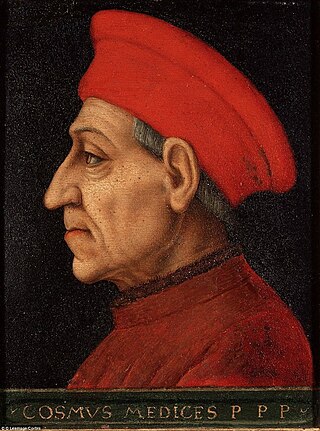
Cosimo di Giovanni de' Medici was an Italian banker and politician who established the Medici family as effective rulers of Florence during much of the Italian Renaissance. His power derived from his wealth as a banker and intermarriage with other rich and powerful families. He was a patron of arts, learning, and architecture. He spent over 600,000 gold florins on art and culture, including Donatello's David, the first freestanding nude male sculpture since antiquity.

Cosimo I de' Medici was the second duke of Florence from 1537 until 1569, when he became the first grand duke of Tuscany, a title he held until his death.

Bertha Maria Júlia Lutz was a Brazilian zoologist, politician, and diplomat. Lutz became a leading figure in both the Pan American feminist movement and human rights movement. She was instrumental in gaining women's suffrage in Brazil and represented her country at the United Nations Conference on International Organization, signing her name to the United Nations Charter and championing the inclusion of Article 8 in the Charter. In addition to her political work, she was a naturalist at the National Museum of Brazil, specializing in poison dart frogs. She has four frog species and two lizard species named after her.

Beatrice "Bice" di Folco Portinari was an Italian woman who has been commonly identified as the principal inspiration for Dante Alighieri's Vita Nuova, and is also identified with the Beatrice who acts as his guide in the last book of his narrative poem the Divine Comedy, Paradiso, and during the conclusion of the preceding Purgatorio. In the Comedy, Beatrice symbolises divine grace and theology.

Lina Bo Bardi, born Achillina Bo, was an Italian-born Brazilian modernist architect. A prolific architect and designer, she devoted her working life, most of it spent in Brazil, to promoting the social and cultural potential of architecture and design. While she studied under radical Italian architects, she quickly became intrigued with Brazilian vernacular design and how it could influence a modern Brazilian architecture. During her lifetime it was difficult to be accepted among the local Brazilian architects, because she was both a "foreigner" and a woman.

Emilio de' Cavalieri, or Emilio dei Cavalieri, was an Italian composer, producer, organist, diplomat, choreographer and dancer at the end of the Renaissance era. His work, along with that of other composers active in Rome, Florence and Venice, was critical in defining the beginning of the musical Baroque era. A member of the Roman School of composers, he was an influential early composer of monody, and wrote what is usually considered to be the first oratorio.

Mary Magdalene de' Pazzi, OCarm, was an Italian Carmelite nun and mystic. She has been declared a saint by the Catholic Church.

Romola (1862–63) is a historical novel written by English author Mary Ann Evans under the pen name of George Eliot set in the fifteenth century. It is "a deep study of life in the city of Florence from an intellectual, artistic, religious, and social point of view". The story takes place amidst actual historical events during the Italian Renaissance, and includes in its plot several notable figures from Florentine history.
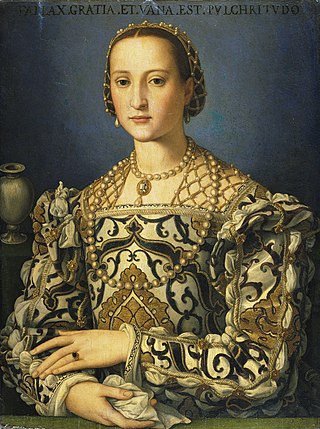
Eleanor of Toledo was a Spanish noblewoman who became Grand Duchess of Florence as the first wife of Cosimo I de' Medici. A keen businesswoman, she financed many of her husband's political campaigns and important buildings like the Pitti Palace. She ruled as regent of Florence during his frequent absences: Eleanor ruled during Cosimo's military campaigns in Genoa in 1541 and 1543, his illness from 1544 to 1545, and again at times during the war for the conquest of Siena (1551–1554). She founded many Jesuit churches. She is credited with being the first modern first lady or consort.
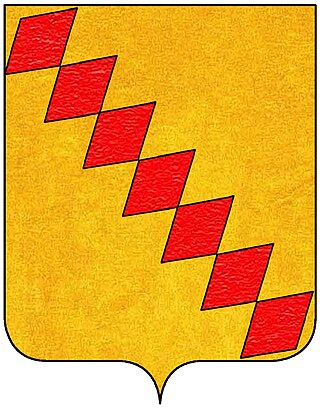
The House of Bardi was an influential Florentine family that started the powerful banking company Compagnia dei Bardi. In the 14th century the Bardis lent Edward III of England 900,000 gold florins, a debt which he failed to repay along with 600,000 florins borrowed from the Peruzzi family, leading to the collapse of both families' banks. During the 15th century the Bardi family continued to operate in various European centres, playing a notable role in financing some of the early voyages of discovery to America including those by Christopher Columbus and John Cabot.
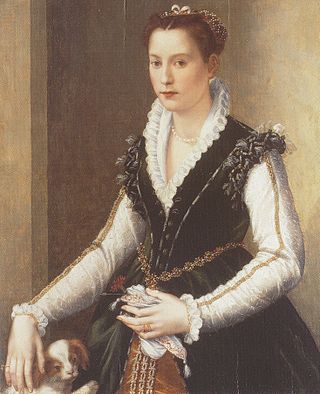
Isabella Romola de' Medici was the daughter of Cosimo I de' Medici, first Grand Duke of Tuscany, and Eleonora di Toledo. She received a humanist education alongside her brother, Francesco de' Medici, who succeeded their father as the Grand Duke of Tuscany. To secure a relationship with the powerful Roman Orsinis, Isabella's father arranged her marriage to Paolo Giordano I Orsini when she was 16. She remained in her father's household after her marriage, giving her an unusual degree of independence for a woman of her period. Following the death of her father, Isabella was probably murdered, with the complicity of her husband and brother, and in retribution for her relationship with Paolo Giordano's cousin Troilo Orsini.

Giovanni di Cosimo de' Medici was an Italian banker and patron of arts.

Dame Bertha Surtees Phillpotts was an English scholar in Scandinavian languages, literature, history, archaeology and anthropology.
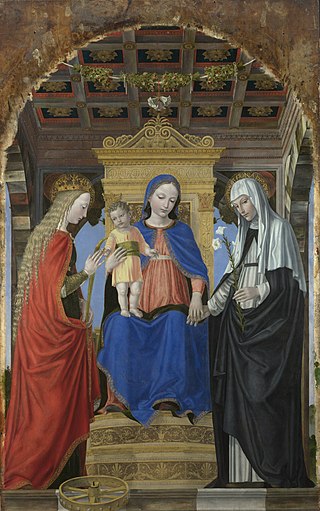
The mystical marriage of Saint Catherine covers two different subjects in Christian art arising from visions received by either Catherine of Alexandria or Catherine of Siena (1347–1380), in which these virgin saints went through a mystical marriage wedding ceremony with Christ, in the presence of the Virgin Mary, consecrating themselves and their virginity to him.

Lorenzo di Bicci was an Italian painter of the Florentine School considered to be one of the most important painters in Florence during the second half of the 14th century. He is believed to have learned his trade from his father, about whom little is known. Lorenzo’s style, as well as that of his contemporaries Jacopo di Cione and Niccolò di Pietro Gerini, was influenced by the artist Andrea di Cione. Lorenzo's paintings made use of bright colors and his compositions avoided complexity. The figures he painted tended to have round faces and were often expressionless. Another one of Lorenzo's distinctive characteristics was his precision of execution. He was known for exceptional talent in drawing, an ability that he put to use at the initial stages of his painting. Unlike many celebrated Florentine artists of this period, Lorenzo mostly received commissions from the country clergy and from the lower-middle-class Florentine guilds. His successors, Bicci di Lorenzo and Neri di Bicci, continued to serve these groups.

Contessina de' Bardi, was an Italian noblewoman from the House of Bardi. Her marriage into the House of Medici provided her husband's family with much needed nobility, prestige, and military support as they established their power in Florence.

Lucrezia Tornabuoni was an Italian noblewoman, wife of Piero di Cosimo de' Medici, de facto Lord of Florence and his political adviser. Lucrezia had significant political influence during the rule of her husband and then of her son Lorenzo the Magnificent, investing in several institutions and improving relationships to support the needs of the poor. She was also a patroness of the arts who wrote several poems and plays.

Bertha Van Hoosen was an American surgeon devoted to women's health issues and the advancement of fellow women surgeons. Among other notable achievements, Van Hoosen was the first president and a founder of the American Medical Women's Association in 1915 and the first woman to be head of a medical division at a coeducational university. She published an autobiography detailing her personal experiences in medicine, Petticoat Surgeon.
References
- 1 2 3 4 Dunbar, Agnes Baillie Cunninghame (1904). A Dictionary of Saintly Women. Harvard University. p. 120. ISBN 9780722217290 . Retrieved 28 September 2023.
- ↑ Bennett, Judith M; Karras, Ruth Mazzo, eds. (2013). The Oxford Handbook of Women and Gender in Medieval Europe. Oxford University Press. p. 457.